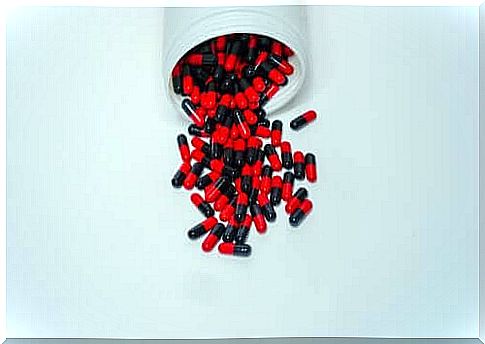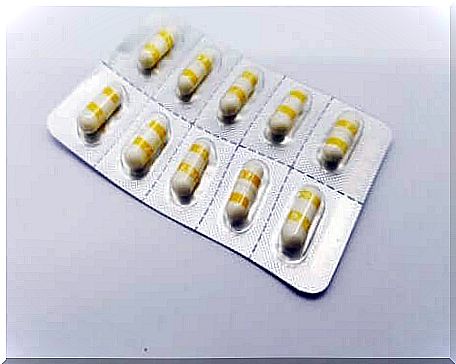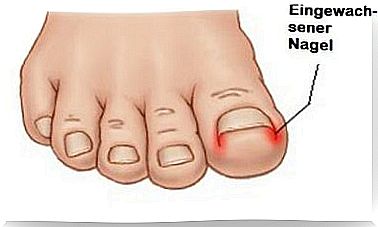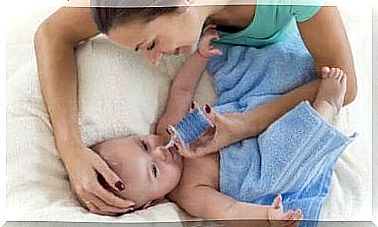Ampicillin: Use And Precautions
The cell wall is a vital structure for bacteria. When their synthesis is disrupted, they die, and in order to achieve this, ampicillin blocks the final phase of cell wall formation. Find out more about this topic in our post today!

Ampicillin is an antibiotic from the family of β-lactam antibiotics (aminopenicillins). It is the first semi-synthetic penicillin to be developed.
Ampicillin was synthesized by the GlaxoSmithKline (GSK) pharmaceutical laboratory between 1959 and 1961. It has been widely used to treat bacterial infections since 1961.
This drug was developed because the bacteria became resistant to penicillin. Therefore the aim was to find a drug with a broader spectrum.
Together with amoxicillin, it is one of the most important aminopenicillins that are commercially available. This is used to treat infections caused by gram-positive and gram-negative bacteria and anaerobic microorganisms. We will then also show the clinical uses of this drug.
How does ampicillin affect the organism?

It is a bactericidal antibiotic, which means that this drug is capable of producing the death of pathogenic microorganisms. Its antimicrobial effect is due to its ability to interfere with the formation of the bacterial cell wall.
The cell wall is a vital structure for bacteria. In order to multiply, bacteria have to constantly rebuild their cell wall, but ampicillin blocks the last phase of cell wall formation. The drug binds to the penicillin binding proteins (PBPs), which are specifically present in the bacterial cell wall.
Ampillicin does not kill the bacteria directly, but hampers their division and reproduction, because they have a bacteriostatic effect. However, there are various bacteria that have developed resistance to these types of antibiotics. They have β-lactam enzymes that are capable of breaking down the chemical structure of ampicillin, rendering the drug ineffective.
Application of ampillicin
As already mentioned, this drug is used in bacterial infections. Specifically, it treats diseases that are triggered by the following bacteria:
- Listeria monocytogenes
- Haemophilus influenzae (which do not produce β-lactam)
- Neisseria meningitidis
- Bordetella pertussis
Ampicillin is used to treat infections caused by microorganisms that are sensitive to this drug. Some examples of this are otitis media, sinusitis, and cystitis.
Pharmacokinetics: what happens to ampicillin in the body?

Pharmacokinetics describes the processes of absorption, distribution, metabolism and excretion of a drug. Ampicillin can be administered orally or parenterally, depending on the patient’s needs. Oral intake represents around 30 to 55% of the dose.
It must be taken into account that absorption is inhibited if ampicillin is taken orally after a meal. Therefore, patients are given this drug on an empty stomach.
After the drug has been absorbed, it needs plasmatic proteins for distribution, but only in a very small percentage. It is distributed very widely and is also able to cross the blood-brain barrier. That is why this medicine is also used for meningitis. However, it is unable to cross the placenta.
The drug is metabolized into molecules that have no activity and are mainly discharged through the urine.
Dosage: which dose is recommended?
When determining the dosage, the doctor takes into account oral or parenteral administration. The following dosage is recommended for parenteral administration:
- Adults and adolescents: The drug is administered intravenously or intramuscularly at a dose between 0.5 and 1 g every 6 hours.
- Children and babies: The dose is 100/200 mg / kg distributed over the day at intervals of 4 to 6 hours.
Oral administration takes place according to the following pattern:
- Adults and adolescents: The dosage is between 0.25 and 1 g and takes place every 6 hours. The total daily dose must never exceed 14 g.
- Children: The dose is reduced to 50 to 100 mg / kg distributed over the day with intervals of 6 hours.
The doctor’s recommendations must be strictly followed, as the doctor adjusts the dosage to the specific needs of each patient. Medicines with antibiotic effects must never be used without a prescription.
Conclusion
Ampicillin is a medicine in the penicillin family. Due to the abuse and incorrect use of this active ingredient, it has significantly lost its effectiveness. The bacteria develop ever greater resistance. It is therefore essential not to self-medicate and always follow the doctor’s recommendations exactly.









